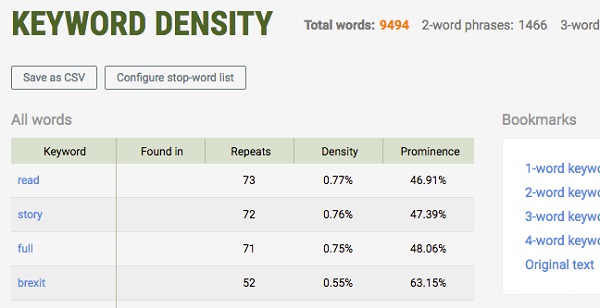
Keyword density is a critical component of on-page SEO. When used effectively, it can help attract search engines and increase the visibility of a page on search engine results pages (SERPs). When ignored, it might prevent a page from ranking or possibly result in a search penalty, which removes it entirely from SERPs.
This essay will define keyword density and show you how to apply it appropriately. As a result, you can gain the benefits of completely optimized content while avoiding the dangers associated with this SEO best practice.
What Exactly Is Keyword Density?
Keyword density is a component of keyword optimization that refers to how many times a target keyword appears on a webpage. It is a percentage that indicates how frequently the target term appears in relation to the total number of words on the page. One indication that search engines can use to identify whether or not a piece of information is related to a specific keyword or phrase is keyword density.
How Is Keyword Density Determined?
It is rather simple to learn how to calculate the keyword density. Simply divide the total number of words on the page by the number of times the target term appears on the page.
Keyword density = the number of times the target keyword appears / the number of words on a webpage.
Here’s an example of keyword density:
The website huddle.com has a page about project management. The page uses the keyword project management 20 times and has a total of 1,000 words.
20 (the number of times the word “project management” appears on the page) / 1,000 (the number of words on the page) = 2% (Density of keywords)
What Is the Appropriate Keyword Density?
Regrettably, there is no hard and fast rule for how many times a keyword should appear on a page. Because search engines do not publish a target keyword density %, you must rely on common sense and best practices to guide you.
The majority of SEO professionals say that an ideal keyword density is between 1-2 percent. This suggests that the target keyword appears one to two times out of every 100 words. At this rate, the phrase occurs frequently enough for search engines to understand what the page is about without resorting to keyword stuffing.
What Exactly Is Keyword Stuffing?
Keyword stuffing is the practice of repeatedly repeating the same target keyword in order to rank the page for the target term. This was once a popular black hat SEO strategy. While keyword stuffing is not extensively utilized in this manner nowadays, marketers should be aware of it so that they do not inadvertently partake in it.
If a page’s keyword density percentage is exceedingly high, it may appear to use keyword stuffing. You should avoid doing this since keyword stuffing violates Google’s quality criteria and can result in search engine penalties that remove the page from SERPs.
Excessive keyword density might also degrade the reading experience. It can have an impact on the clarity and readability of your SEO material, forcing users to leave in favor of higher-quality pages.
Read more on Technical Seo, Google penalities
4 Methods for Increasing Keyword Density
Because search engines do not define an ideal keyword density, you should adhere to best practices for keyword optimization rather than a specific keyword density percentage.
The following tactics are the best way to approach keyword density in your content.
1. Write for your audience first, then concentrate on keyword usage
Remember that the finest material is made with the reader in mind. Use the keyword in your writing naturally and organically. Using these content writing techniques as a guide, create high-quality, captivating, and valuable material. Once you’ve finished writing, go back and see if you can naturally incorporate the keyword to get a keyword density of 1-2 percent.
2. Employ keyword stemming to incorporate variations of the target keyword
The ability of a search engine to recognize and correlate similar word forms connected to the target phrase is referred to as keyword stemming. Keyword stemming typically adds a prefix, suffix, or pluralization to a target keyword. For example, project managers or project management could be derived from the phrase project manager. Because search engines identify and correlate these terms, include them in your content to support your goal keyword while also offering textural variation.
3. Make use of semantic keywords to provide context and support for the target term
Semantic keywords are synonyms, variations, or concepts that are contextually related to the target keyword. They are related not by what the words are, but by what they mean. For example, semantic keywords for the goal phrase project manager could include project management or project management. Semantic SEO is used by search engines to comprehend and rank webpages, so locate relevant keywords and utilize them in your material to supplement your on-page SEO.
4. Stay away from keyword stuffing
After you’ve finished your content, use an on-page SEO checklist to double-check your keyword density and other on-page SEO parameters before publishing. Make sure you utilized the target term enough times to tell search engines what the page is about without keyword stuffing and risking search penalties.
How to Determine Keyword Density
You can check keyword density manually by counting your keyword usage and the total number of words and applying the calculation above. You may also evaluate keyword density within your WordPress post editing page using a tool like the Yoast SEO Plugin.
Once your page is up, use Alexa’s On-Page SEO Checker to verify keyword usage and ensure the page is fully optimized for the target term.
How to Find and Use Keywords Correctly
Get tools that help you find the ideal terms to target in your posts and pages now that you understand keyword density and how many times to utilize keywords in your content.
Keyword density is a critical component of on-page SEO. When used effectively, it can help attract search engines and increase the visibility of a page on search engine results pages (SERPs). When ignored, it might prevent a page from ranking or possibly result in a search penalty, which removes it entirely from SERPs.
This essay will define keyword density and show you how to apply it appropriately. As a result, you can gain the benefits of completely optimized content while avoiding the dangers associated with this SEO best practice.
You May also like sitescorechecker, Pro Site Ranker
